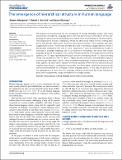| dc.contributor.author | Miyagawa, Shigeru | |
| dc.contributor.author | Berwick, Robert C. | |
| dc.date.accessioned | 2013-04-24T18:32:19Z | |
| dc.date.available | 2013-04-24T18:32:19Z | |
| dc.date.issued | 2013-02 | |
| dc.date.submitted | 2012-11 | |
| dc.identifier.issn | 1664-1078 | |
| dc.identifier.uri | http://hdl.handle.net/1721.1/78592 | |
| dc.description.abstract | We propose a novel account for the emergence of human language syntax. Like many evolutionary innovations, language arose from the adventitious combination of two pre-existing, simpler systems that had been evolved for other functional tasks. The first system, Type E(xpression), is found in birdsong, where the same song marks territory, mating availability, and similar “expressive” functions. The second system, Type L(exical), has been suggestively found in non-human primate calls and in honeybee waggle dances, where it demarcates predicates with one or more “arguments,” such as combinations of calls in monkeys or compass headings set to sun position in honeybees. We show that human language syntax is composed of two layers that parallel these two independently evolved systems: an “E” layer resembling the Type E system of birdsong and an “L” layer providing words. The existence of the “E” and “L” layers can be confirmed using standard linguistic methodology. Each layer, E and L, when considered separately, is characterizable as a finite state system, as observed in several non-human species. When the two systems are put together they interact, yielding the unbounded, non-finite state, hierarchical structure that serves as the hallmark of full-fledged human language syntax. In this way, we account for the appearance of a novel function, language, within a conventional Darwinian framework, along with its apparently unique emergence in a single species. | en_US |
| dc.language.iso | en_US | |
| dc.publisher | Frontiers Research Foundation | en_US |
| dc.relation.isversionof | http://dx.doi.org/10.3389/fpsyg.2013.00071 | en_US |
| dc.rights | Article is made available in accordance with the publisher's policy and may be subject to US copyright law. Please refer to the publisher's site for terms of use. | en_US |
| dc.source | Frontiers Research Foundation | en_US |
| dc.title | The emergence of hierarchical structure in human language | en_US |
| dc.type | Article | en_US |
| dc.identifier.citation | Miyagawa, Shigeru, Robert C. Berwick, and Kazuo Okanoya. “The Emergence of Hierarchical Structure in Human Language.” Frontiers in Psychology 4 (2013). | en_US |
| dc.contributor.department | Massachusetts Institute of Technology. Department of Electrical Engineering and Computer Science | en_US |
| dc.contributor.department | Massachusetts Institute of Technology. Department of Linguistics and Philosophy | en_US |
| dc.contributor.department | Massachusetts Institute of Technology. Foreign Languages and Literatures | en_US |
| dc.contributor.department | Massachusetts Institute of Technology. Laboratory for Information and Decision Systems | en_US |
| dc.contributor.mitauthor | Miyagawa, Shigeru | |
| dc.contributor.mitauthor | Berwick, Robert C. | |
| dc.relation.journal | Frontiers in Psychology | en_US |
| dc.eprint.version | Final published version | en_US |
| dc.type.uri | http://purl.org/eprint/type/JournalArticle | en_US |
| eprint.status | http://purl.org/eprint/status/PeerReviewed | en_US |
| dspace.orderedauthors | Miyagawa, Shigeru; Berwick, Robert C.; Okanoya, Kazuo | en |
| dc.identifier.orcid | https://orcid.org/0000-0002-1061-1871 | |
| dc.identifier.orcid | https://orcid.org/0000-0002-6134-9463 | |
| mit.license | PUBLISHER_POLICY | en_US |
| mit.metadata.status | Complete | |

